Related Research Articles

Georges Carpentier was a French boxer, actor and World War I pilot. A precocious pugilist, Carpentier fought in numerous categories. He fought mainly as a light heavyweight and heavyweight in a career lasting from 1908 to 1926. A French professional champion on several occasions, he became the European heavyweight champion before the First World War. A sergeant aviator during the Great War, he was wounded before returning to civilian life. He then discovered rugby union, playing as a winger.

William Harrison "Jack" Dempsey, nicknamed Kid Blackie and The Manassa Mauler, was an American professional boxer who competed from 1914 to 1927, and reigned as the world heavyweight champion from 1919 to 1926. A cultural icon of the 1920s, Dempsey's aggressive fighting style and exceptional punching power made him one of the most popular boxers in history. Many of his fights set financial and attendance records, including the first million-dollar gate. He pioneered the live broadcast of sporting events in general, and boxing matches in particular.

Luis Ángel Firpo was an Argentine boxer. Born in Junín, Argentina, he was nicknamed The Wild Bull of the Pampas. He was the first Latin American in history to challenge for the world heavyweight title. His bout against Jess Willard set a world record for boxing attendance. And his heavyweight title bout against Jack Dempsey was named Ring Magazine Fight of the Year for 1923.

James Joseph Tunney was an American professional boxer who competed from 1915 to 1928. He held the world heavyweight title from 1926 to 1928, and the American light heavyweight title twice between 1922 and 1923. A highly technical boxer, Tunney had a five-fight light heavyweight rivalry with Harry Greb in which he won three, lost once, and drew once, though many ringside reporters believed Greb should have won the decision in their second meeting. Tunney also knocked out Georges Carpentier and defeated Jack Dempsey twice; first in 1926 and again in 1927. Tunney's successful title defense against Dempsey remains one of the most famous bouts in boxing history and is known as The Long Count Fight. He retired undefeated as a heavyweight after his victory over Tom Heeney in 1928, after which Tunney was named Fighter of the Year by The Ring magazine.

Edward Henry Greb was an American professional boxer. Nicknamed "The Pittsburgh Windmill", "The Smoke City Wildcat" and "The Pittsburgh Bearcat," he is widely regarded by many boxing historians as one of the best pound for pound boxers of all time.
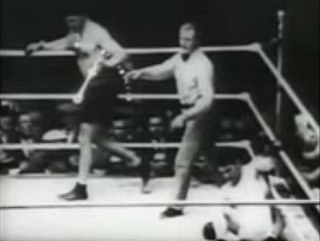
The Long Count Fight, or the Battle of the Long Count, was a professional boxing 10-round rematch between world heavyweight champion Gene Tunney and former champion Jack Dempsey, which Tunney won in a unanimous decision. It took place on September 22, 1927, at Soldier Field in Chicago. "Long Count" is applied to the fight because, when Tunney was knocked down in the seventh round, the count was delayed due to Dempsey's failure to go to and remain in a neutral corner. Whether this "long count" actually affected the outcome remains a subject of debate.
Boxing in the 1920s was an exceptionally popular international sport. Many fights during this era, some 20 years away or so from the television era, were social events with many thousands in attendance, both men and women.

Jack Sharkey was a Lithuanian-American boxer who held the NYSAC, NBA, and The Ring heavyweight titles from 1932 to 1933.
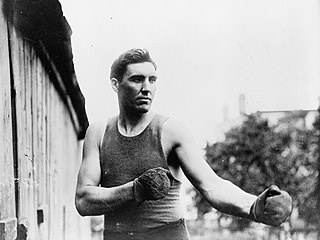
Jess Myron Willard was an American world heavyweight boxing champion billed as the Pottawatomie Giant. He won the world heavyweight title in 1915 by knocking out Jack Johnson.
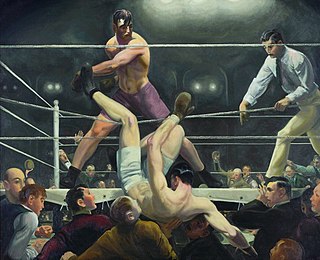
Jack Dempsey vs. Luis Ángel Firpo was a boxing match and one of the most significant events in sports of the era. It was the first time that a Latin American challenged for the world heavyweight title. The bout was named Ring Magazine Fight of the Year for 1923. The painting Dempsey and Firpo by George Bellows, showing Firpo knocking Dempsey out of the ring, is an iconic piece of Americana.

George Lewis "Tex" Rickard was an American boxing promoter, founder of the New York Rangers of the National Hockey League (NHL), and builder of the third incarnation of Madison Square Garden in New York City. During the 1920s, Tex Rickard was the leading promoter of the day, and he has been compared to P. T. Barnum and Don King. Sports journalist Frank Deford has written that Rickard "first recognized the potential of the star system." Rickard also operated several saloons, hotels, and casinos, all named Northern and located in Alaska, Nevada, and Canada.

Harry Wills was a heavyweight boxer who held the World Colored Heavyweight Championship three times. Many boxing historians consider Wills the most egregious victim of the "color line" drawn by white heavyweight champions. Wills fought for over twenty years (1911–1932), and was ranked as the number one challenger for the throne, but was denied the opportunity to fight for the title. Of all the black contenders between the heavyweight championship reigns of Jack Johnson and Joe Louis, Wills came closest to securing a title shot. BoxRec ranks him among 10 best heavyweights in the world from 1913 to 1924, and as No.1 heavyweight from 1915 to 1917.

Jack Delaney was a world light heavyweight boxing champion and contender for the heavyweight crown. One of the most popular fighters of the 1920s, the French Canadian was born Ovila Chapdelaine in Saint-François-du-Lac, Quebec, Canada. His parents moved their family to the United States on August 15, 1904, where they initially lived in Holyoke, Massachusetts before settling in Bridgeport, Connecticut. Delaney became a United States Citizen on October 23, 1936.
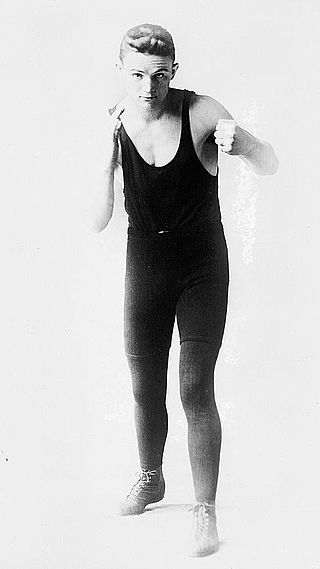
Thomas Joseph Gibbons was an American professional heavyweight boxer.

Bill Brennan was an American boxer who fought and lost to World Heavyweight Champion Jack Dempsey in a well attended title fight that ended in a twelfth-round knockout on December 14, 1920, in Madison Square Garden. He lost to Dempsey for the first time in a non-title fight on February 5, 1918, in Milwaukee, Wisconsin, in a sixth-round technical knockout.

Barney Lebrowitz, better known as Battling Levinsky, was an American boxer who was the world light heavyweight champion from 1916 to 1920. Statistical boxing website BoxRec lists Levinsky as the #12 ranked light heavyweight of all time, while The Ring Magazine founder Nat Fleischer placed him at #9. The International Boxing Research Organization rates Levinsky as the 20th best light heavyweight ever. He was inducted into the Ring Magazine Hall of Fame in 1966, the International Jewish Sports Hall of Fame in 1982, and the International Boxing Hall of Fame in 2000.
Long count or slow count is a term used in boxing. When a boxer is knocked down in a fight, the referee will count over them and the boxer must rise to their feet, unaided, by the count of ten or else deemed to have been knocked out. A long count occurs when a boxer is given more than the allotted time to rise to his or her feet.
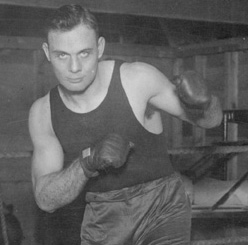
Floyd Johnson, nicknamed "The Auburn Bulldog", was an American heavyweight boxer who was known for his stiff punch. His (incomplete) boxing record comes out to: 38 wins, 13 losses, and 11 draws. In 1923, he was considered a leading contender, and described in Time magazine as "possibly the fifth-best heavyweight in the ring." His manager was Alec Greggains. After his boxing career ended, he went into promotion in White Center, Washington. and served as a deputy sheriff in King County, Washington, in the mid-1920s.

Boyle's Thirty Acres was a large wooden bowl arena in Jersey City, New Jersey. It was built specifically for the world heavyweight championship bout between Jack Dempsey of the United States and Georges Carpentier of France on July 2, 1921. It held approximately 80,000 fans and was built at a cost of $250,000. It was situated around Montgomery Street and Cornelison Avenue, on a plot of marshland owned by John F. Boyle.

Jack Dempsey vs. Georges Carpentier was a boxing fight between world heavyweight champion Jack Dempsey and world light-heavyweight champion Georges Carpentier, which was one of the fights named the "Fight of the Century". The bout took place in the United States on Saturday, July 2, 1921, at Boyle's Thirty Acres in Jersey City, New Jersey.
References
- ↑ O'Connor, John J. (1983-09-28). "TV: 'DEMPSEY,' TALE OF FIGHT YEARS". The New York Times. ISSN 0362-4331 . Retrieved 2023-04-24.
- ↑ Etling, Laurence (2014-01-10). Radio in the Movies: A History and Filmography, 1926-2010. McFarland. p. 116. ISBN 978-0-7864-8616-8.